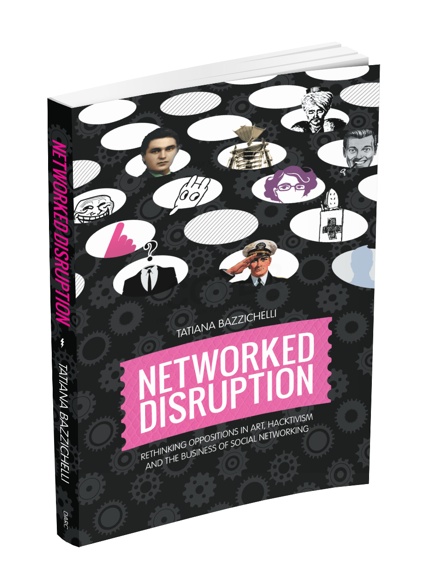A few days ago, i was on video skype for an interview with Tatiana Bazzichelli and her irresistible Italian accent.
I had long wanted to sit down properly and have a chat with Tatiana. The reasons for that are many. First of all, Tatiana is one of the few people who knows the world of art but also the hacking community from the inside. Besides, she has a strong academic and curatorial background.
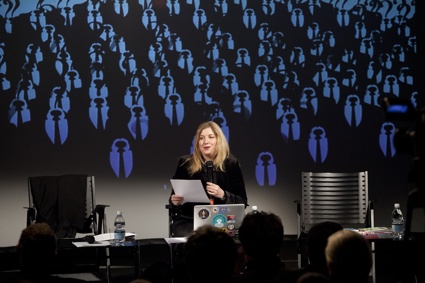 Tatiana Bazzichelli at the seminar Networked Disruption, Kino Šiška, Ljubljana, March 11, 2015. Photo: Miha Fras
Tatiana Bazzichelli at the seminar Networked Disruption, Kino Šiška, Ljubljana, March 11, 2015. Photo: Miha Fras
Bazzichelli is a curator and researcher, author of the books Networked Disruption. Rethinking Oppositions in Art, Hacktivism and the Business of Social Networking (2013), Networking. The Net as Artwork (2008), and co-editor of the book Disrupting Business. Art & Activism in Times of Financial Crisis (highly recommended, like all her book this one is available as paperback but also as a free download). She is director of the Disruption Network Lab, an experimental curatorial project on art, hacktivism, and disruption, based in Berlin. We’ll talk during the interview about the upcoming activities of the lab but do not miss its opening event this month, it’s called Drones and it examines drone warfare through the perspectives of a former U.S. drone operator, an artist, a criminal law researcher, investigative journalists, activists, filmmakers and a series of international experts.
Previous to that, Tatiana was programme curator at the transmediale festival, initiating the year-round reSource transmedial culture project, and was a Post-Doctoral researcher at the Centre for Digital Cultures, Leuphana University of Lüneburg.
The second reason why i wanted to steal a moment from Tatiana Bazzichelli’s life is Networked Disruption, an exhibition and a series of events she has curated. If you’re in Ljubljana (lucky you!) you have until Friday to check out the show at the Škuc Gallery. Right after that, the exhibition will move to the Museum of Modern and Contemporary Art in Rijeka. Future events in other European cities are on the agenda.
Centered on the concept of “Networked Disruption” (a concept which is analyzed in depth in her book of the same name), the exhibition highlights the mutual interferences between business, art and disruption. Because it brings together the heterogeneous practices of hackers, artists, networkers, whistleblowers, activists and entrepreneurs, the show is dense in reflections, provocations and references to contemporary society.
The increasing commercialisation of sharing and networking contexts since the middle of 2000s is transforming the meaning of art and that of business. What were once marginal practices of networking in underground hacker and artistic contexts have in recent years become a core business for many information technology companies and social media enterprises. In Bazzichelli’s analysis, art intertwines with disruption beyond dialectical oppositions, leading to a discovery of subliminal and distributed strategies, which emerge from within the capitalistic systems, or act within it.
Here is the transcript of the interview:
Hi Tatiana! What was the catalyst of your research into the ways artists and hackers can disrupt the system from within? How and why did it start?
In 2008, I moved to Denmark to do a PhD. The research came from very personal reflections. When you and i first met a few years ago, i was interested in questions of sexuality and practices of queer culture. At the same time, i was also speaking about practices of hacking as a form of openness and DIY in connection with political activity.
However, around 2004-2005, I think that there was a moment of change because we started to get into a more mainstream social media framework. This for me modified the perspective because i think many people, who were part of our underground political culture, started to use tools that were becoming common at the time. I noticed that many people -and that includes the net art culture- started to be on Facebook and many of the conversations were happening there. It was a real surprise for me. I could not understand how it was possible that people like us, who used to be really critical, started to shift the field of conversation and action to Facebook.
For example, before Facebook, many people were using MySpace and here in Berlin it was the platform that was popular among the club scene. From MySpace people later migrated to Facebook. Many of these people came from the queer culture and were always speaking of the pleasure as coming from your own understanding of the body but also as a political mean. But when you are just clicking “Like” all the time on Facebook, you transfer your pleasure into a commodified value. “Like” means ‘it gives me pleasure’ but it also translates into a way for corporations to make money through advertisement. So i was at the time a bit upset.
Then in 2004 i went to this conference in Berlin. It was organized by Tim O’Reilly. It was the time when they were really launching this concept of Web 2. 0, both as a theme and as a business model.
What surprised me at the conference is that they were using the idea of hacking, DIY and many characteristics of the hacker culture to present their products. And i remember Tim O’Reilley at that conference saying that data is the next ‘Intel Inside’. I found it a bit strange that the ideas of DIY, openness, sharing, participation were becoming a business model. Even if we always say that business and art are totally intertwined, i was surprised to hear that this could also apply to hacker culture because i was coming from a more politically-oriented hacking.
When i started my PhD in 2008, i wanted to investigate this process: how hacking, business and art started to be so intertwined and what were the consequences for our community of net artists, hackers and so on. As we know that Web 2.0 started as a concept in the Silicon Valley, i travelled to San Francisco and California during my PhD and i started to interview a lot of people. I summarized these experiences in the book.
In the book i started talking about the idea of disruption. That was in 2008 when not many people were using the concept of disruption. Now it is a total buzz word in many contexts, including political, artistic or hacker practices. Disruption is a term coming from business. If we want to define the term disruption, it means to introduce a product, a technology or an innovation that the market doesn’t expect. This is usually a definition used by many start-ups to define the way they create disruptive innovation. The idea is that you introduce into the market an innovation that is often cheaper than the other products already available and in this way you create a disruption because you shift the public and the consumers into using the new product. This component of being unexpected is important. But what is equally important is that the discourse of disruption comes from inside this system.
In my previous experiences, i used to think that sometimes it was good to create opposition in order to trigger a change. It was the time right after the anti globalization movement, when we had to reflect on tactics that were often characterized by a component of opposition. Many people started to think that we needed to invent new forms of criticism. And that’s why i was so interested in the queer community because they were usually adopting tactics that were playful and not merely oppositional of the system as many people were doing for example during the G8 manifestations when disobedience was applying a very frontal opposition. After the massacre of the 2001 G8 Summit in Genoa, we could see that the movement had to rethink its strategies. So i started to investigate different forms of practices that were working from within or adopting viral and playful strategies. Initially, I looked into queer culture but then after web 2.0, i moved into business because i could see that it was a second step that needed to be analyzed.
After the PhD, i i started to write about disruption and i saw that it could be applied to the art field. Just like the business is speaking about disruptive innovation, i thought maybe we should apply this concept to the art field and start to imagine practices that are actually coming from within the system and are also using this unpredictability as a form of tactical strategy, just like businesses do.
Of course it’s not something new. The avant-garde for example created an artistic shock and used the idea of the unpredictability of practices. Following these lines and somehow transforming it into the present condition of net culture, i thought disruption could then be applied as an artistic practice and also analyze its loop.
In my book, this loop brings together art, business and disruption.
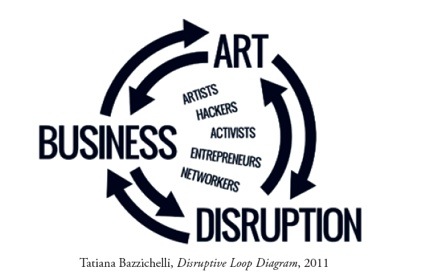 Tatiana Bazzichelli, Disruptive Loop Diagram, 2011
Tatiana Bazzichelli, Disruptive Loop Diagram, 2011
If you understand how i conceptualize this model, then you can see how artists, activists, hackers, entrepreneurs, networkers are all inside this loop because they act from within the system. The mutual interferences and the mutual feedback loop happen between business, art and disruption. In my model, art is disrupting business by creating interferences, perturbations and virality inside the business field. I use the word business because it’s a word that artists and activists despise. Business is directly connected to managerial thinking, to company rhetoric, etc. If you read artistic texts, you will find that they talk about market, not business. And that’s why i decided to use the word. I think we have to start appropriating an imaginary and words that have never been parts of certain fields, like art and hacking. Or that used to be if we go back in time. The critical fields of artists and hackers however hate that word. So i thought we should start to appropriate the word business, just like the word hacking has been appropriated by web 2.0.
You curated an exhibition that is currently on view at the Škuc gallery in Ljubljana. Could you take us through some of the works you are showing there and tell us how they fit into the “disruptive feedback loop”, how they embody this idea of networked disruption?
The idea for this exhibition was to refer to the book because the people who are part of the exhibition are also featured in the book but i also wanted to bring it to the present. That was a bit complicated because when you write a Phd you don’t necessarily start to think about how to translate it into an exhibition.
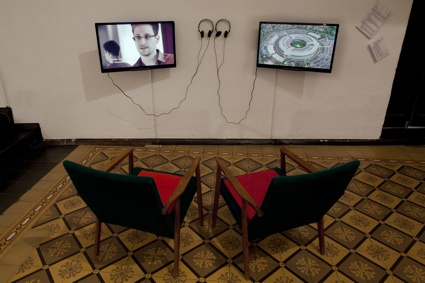 Networked Disruption. Exhibition view at Škuc Gallery. Photo: Miha Fras
Networked Disruption. Exhibition view at Škuc Gallery. Photo: Miha Fras
I also wanted to try and reflect on the modality of curating, of presenting networks of networks that are all dealing with disruption and at the same time i wanted to have the opportunity to reflect on what disruption means as a strategy that is interfering with from within the systems. At that point i’m going to mention another reflection i made in the book about whistleblowing. Whistleblowers are people who are not only acting inside the system (they work for corporations, secret services, governmental agencies, etc.) but to me, they are also creating détournements of perspective because they facilitate an important moment of change. And there is also this idea of unpredictability. A person who was regularly working for a corporation or an agency is suddenly turning out to be somebody who’s revealing the misconducts of the corporation or entity they work for.
I think that whistleblowers are actually artists because if we think about the history of art, going back to the Avant-garde and reflecting on this moment of détournement, shock, change and unpredictability, then it is exactly what whistleblowers are doing. They create shock and change And it’s interesting because this applies also outside the metaphysical aspects of art. I mean it’s not just civil disobedience, it’s something that is having consequences on their daily life. There is no way back for them.
In that sense, it is also a very important act. Everyone could be a whistleblower. Every person who works into this closed system could wake up and say “I don’t want to do this anymore” and they could start revealing secrets. It’s also really interesting for me because it happens in the context of everyday life. We could say that the avant-garde was still really working into the art field. The idea was to bring life in to art… You know the usual sentence! But the perspective changed after the end of the seventies, even with punk culture or the idea of hacker cultures and many of the practices exhibited in the show, such as Luther Blissett and Neoism. These people had the idea of bringing art into life. It’s thus something different. And that’s what i’m interested in. I’m interested in the moments when art goes out of the usual structures and constraints and becomes something that everybody could apply into their own life. From this point of view, a whistleblower is an artist because he or she totally follows a perspective in which you create détournement of a point of view. That’s the reason why i included some whistleblower projects and some practices connected to whistleblowing in the exhibition.
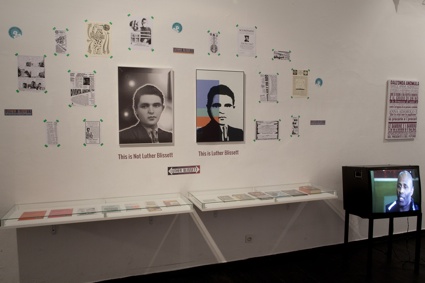 Networked Disruption. Exhibition view at Škuc Gallery. Photo: Miha Fras
Networked Disruption. Exhibition view at Škuc Gallery. Photo: Miha Fras
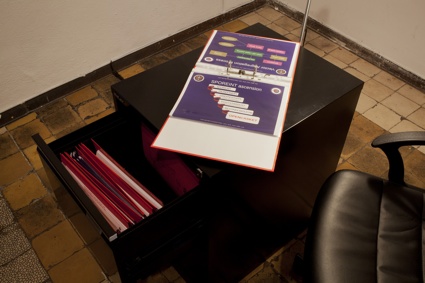 Networked Disruption. Exhibition view at Škuc Gallery. Photo: Miha Fras
Networked Disruption. Exhibition view at Škuc Gallery. Photo: Miha Fras
In the first room of the show, you can see the work of Julian Oliver, Laura Poitras, Trevor Paglen. Then we look at the roots of practices that come from subcultural groups that were active in the 80s and 90s (Luther Blisset, the Neoism movement, The Cacophony Society, the Billboard Liberation Front, etc.
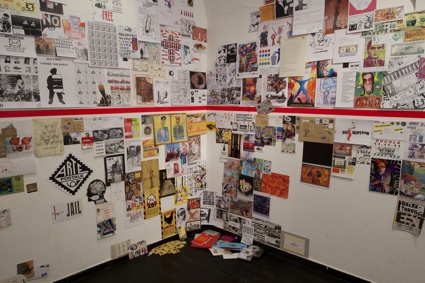 Networked Disruption. Exhibition view at Škuc Gallery. Photo: Miha Fras
Networked Disruption. Exhibition view at Škuc Gallery. Photo: Miha Fras
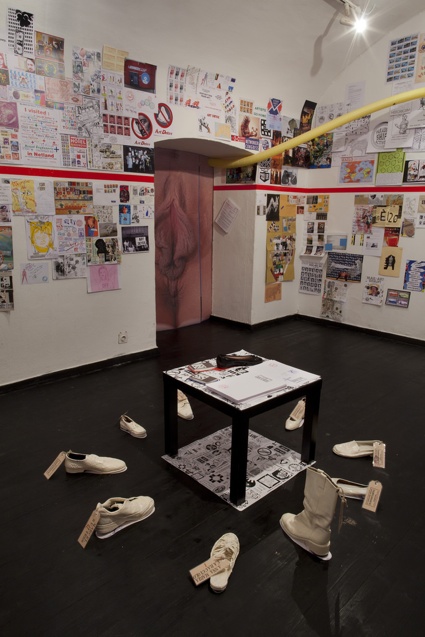 Networked Disruption. Exhibition view at Škuc Gallery. Photo: Miha Fras
Networked Disruption. Exhibition view at Škuc Gallery. Photo: Miha Fras
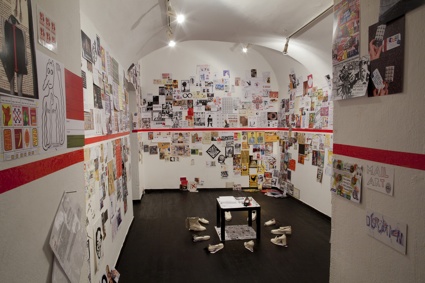 Networked Disruption. Exhibition view at Škuc Gallery. Photo: Miha Fras
Networked Disruption. Exhibition view at Škuc Gallery. Photo: Miha Fras
And of course mail art because mail art has a connection with art, and also because mail artists spoke about how art does not necessarily have to be connected with the gallery system. Everybody can be an artist, everybody can do mail art. Besides, in some situations, people used mail art to circumvent surveillance. In the DDR for example.
Together with VIttore Baroni we created a create a timeline of mail art in relation to disruption but we also asked people to send works of disruption to the Škuc gallery.
These lines of inquiry reach the discourse of Anonymous, a practice that is totally in line with the discourse of anonymity and also with the disruption of identity and the discourse of dismantling a single truth. These aspects were already important in Luther Blissett and Neoism, they were playing with the idea of the truth of the media, of the identity, of the art field and they even played with their own practices. Many Neoists were indeed claiming they were not Neoists or they were coming up with different definitions of Neoism. I think that Anonymous is directly connected to that. Not only because the group is made of people whose identity you don’t know but also because they are bringing together this aspect of political engagement but without the political mandate and they are having fun in the process, ‘doing things for the Lulz’ as they say.
Nowadays the moment of criticism is changing, especially for the hacker culture. Today if you want to look for enemies, these enemies are so powerful that you know you will never win the battle. This is the era of Big Data so tell me “Who is the enemy?” Since Snowden, we know about surveillance, we know that the enemy is totally pervasive. So if you want to be critical, then your strategy, your practice also need to be pervasive. I think that this is exactly what Anonymous is doing. Even if their operations identify the so-called ‘enemy’, they are so distributed that you know there is not one single mission. There is a plural aspect of dealing with anonymity. So i found it to be a very important strategy and one directly connected with whistleblowing because we know that one of the last operations was involving AntiSec and Jeremy Hammond. He leaked to wikileaks private data and sensitive information from the Stratfor corporation. That was an act of whistleblowing. And indeed Hammond got 10 years in jail for it.
Connected to that there is also the discourse of Barrett Brown. So you see that everything is connected.
What i’m trying to do in this exhibition is to draw these connections but at the same time i didn’t want to be just the curator in a hierarchical way. I decided that i wouldn’t be the only person taking the decisions. I worked with an internal individual from each group. We decided together to exhibit certain aspects of the entity or group and we were totally conscious that we were not doing a historical exhibition because that would have been impossible. Instead, the show analyzes some specific aspects of each group that we think are important in relation to disruption and then the show connects these aspects together. The idea was then to create a network of networks in relation to networked disruption. The title is thus networkED disruption as in “disruption among networks” and also inside of them. It is also connected to the idea of the disruptive loop because the loop is creating a network for disruption in which different agents participate to a feedback loop.
I was watching the video of the talk you gave at re:public last year. At some point, you were explaining that hacking cannot be disconnected from business in the U.S. You gave Burning Man as an example. Could you expand on this connection?
When i was at Stanford during a visiting scholarship during the PhD research, i met Fred Turner and we had interesting conversations. He wrote this book From Counterculture to Cyberculture. He was claiming that, at least in California, the development of hacker culture was always intertwined with business. He doesn’t like to speak about co-optation but about layering, with things that don’t just co-exist but are intertwined. i was inspired by this idea of layering and i tried to recreate it by analyzing artistic practices. In layering, there is a coexistence of opposition. And they are not oppositions from the outside, the oppositions are all living inside this loop. In my first scenario, i analyzed this practices by referring to Walter Benjamin, especially the idea of dialectical image that is the moment in which oppositions coexist. Business, disruption, art and hacking all together at the same time create something which in Germany they call Denkbilder (‘thinking image’.)
Going back to the exhibition, you could say that it is the coexistence of oppositions because these groups were active at the same time but were never necessarily in contact.
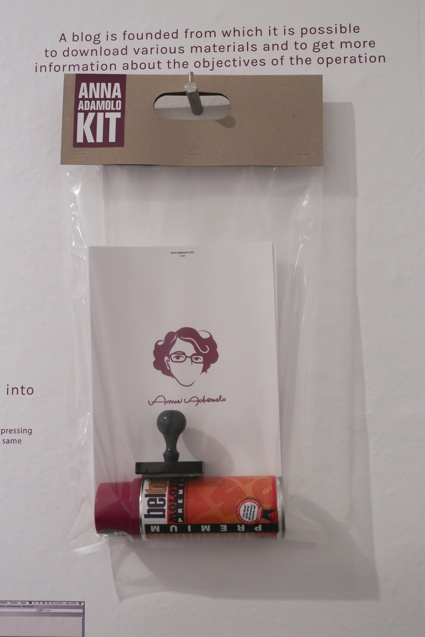 Networked Disruption. Exhibition view at Škuc Gallery. Photo: Miha Fras
Networked Disruption. Exhibition view at Škuc Gallery. Photo: Miha Fras
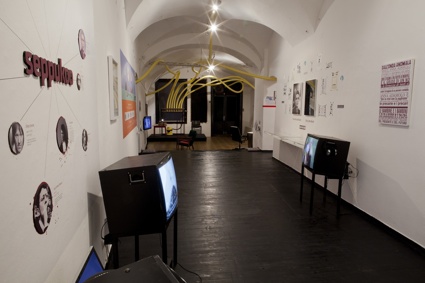 Networked Disruption. Exhibition view at Škuc Gallery. Photo: Miha Fras
Networked Disruption. Exhibition view at Škuc Gallery. Photo: Miha Fras
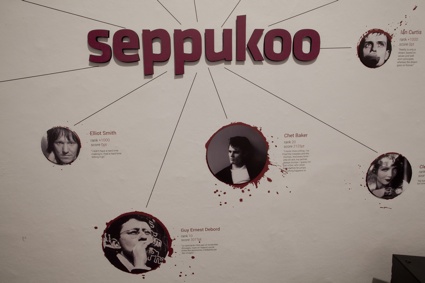 Networked Disruption. Exhibition view at Škuc Gallery. Photo: Miha Fras
Networked Disruption. Exhibition view at Škuc Gallery. Photo: Miha Fras
The show also looks into the idea of business disruption with projects that are directly related to web 2.0 and social media. They are the most recent one such as Anna Adamolo and the collective Les Liens Invisbles. They are analyzing the Facebook system and other social media and creating disruption from within it by really understanding how the system of virality works.
After long discussions with Janez (Janez being one of the producers of the show), we also decided to have a Janez Janša work. We are showing the letter in which the three artists communicate to the Prime Minister Janez Janša that they are becoming Janez Janša. Again, this was a moment of change that interfered with their private life (just like what happened with the whistleblowers). it is also a strong act of creating an unpredictable change in their life and also as artists.
Are you planning to show Networked Disruption anywhere else?
Yes, we are about to move the exhibition to Croatia. The opening is on the 23rd of April and the show will be up until the 14th of May. It’s at the Museum of Contemporary Art in Rijeka. The idea is then to move it to move it to the UK in 2016 as part of the AND Festival. I’m also trying to bring it back to Berlin. So it’s going to be a traveling show.
How did the public react to the show? Did it echo with their own life?
The feedback we got in Slovenia is very positive, including among young people. I don’t want to sound like a grumpy old lady but it is sometimes difficult these days to make young people understand that social networking is a practice that has a history, that Facebook hasn’t invented everything from scratch. The show wants to highlight that social practices can be imagined in a different way, that if you understand a system, you can play with it. And play from the inside.
Trailer of the documentary DRONE directed by Tonje Hessen Schei
You are the director of the Disruption Network Lab in Berlin. I noticed the very promising title of an upcoming event on the homepage. It’s called Launch Event: Drones. What have you programmed for the event?
Last year, i applied to the Hauptstadtkulturfonds, the culture fund of Berlin and i got a grant to develop a one year program (hopefully we will manage to go beyond one year.) My idea was to build upon the PhD research and the practice-based experience i had with Transmediale with the reSource program. So i decided to develop a platform of events and research that will take place at the Kunstquartier Bethanien in Berlin.
There will be 6 main events. One every 6 weeks. They are scheduled in April, May, August, September, October and December. Each event focuses on a different topic but all are aligned with the discourse of disruption as a concept which means ‘to interfere with the system from within.’
Each specific thematic will be analyzed from different points of view. They will also together people who approach the subject from different perspectives. Hackers, artists, whistleblowers, activists, investigative journalists, researchers, critical thinkers, etc.
The first event is called Drones. Eyes from a Distance and we’ll be analyzing the politics and strategies within and behind the drone usage. Somehow, drones are these invisible weapons that you know are used during conflict. They also have some kind of mystical aura. Mystical and horrifying. You know drones can kill people and they do it in a massive way. They are operated at a distance so they are part of the discourse of deterritorialization of conflict. At the same time, drones are becoming widespread in society. Amazon is using them to deliver parcels. Journalists are using them for filming from above. Makers and hackers are using them in their DIY experiments.
So this topic obviously opens up a lot of discussions.
This event will last 2 days. The model of the Disruption Network Lab events is a series of panels, discussions, keynotes and workshops sometimes. We also try to connect with other spaces in Berlin.
For the launch event, we will have a drone operator coming from the US. He used to work in the army there until he decided to become a whistleblower by discussing in public what it means to be a drone operator and how the work interfered with everyday life. There will be a panel with an investigative journalist, a criminal lawyer working specifically on Palestine questions, and activists from Gaza (if we manage to get them here as it’s tricky to get all the permissions).
The following day, we have a second panel with another investigative journalist, an artist working on the mapping of strikes, and then a Norwegian film maker. His film, DRONE, will also be screened at the event.
We will also document the event and upload all the videos online.
Thanks Tatiana!
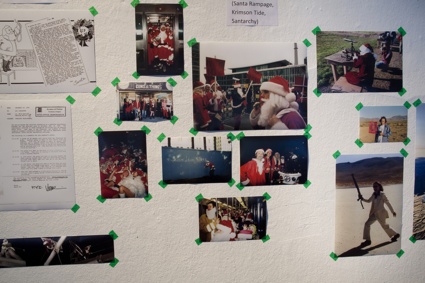 Networked Disruption. Exhibition view at Škuc Gallery. Photo: Miha Fras
Networked Disruption. Exhibition view at Škuc Gallery. Photo: Miha Fras
Networked Disruption, an exhibition and a series of events produced by Aksioma and Drugo more in collaboration with several partners. The show is up until April 3 at Škuc Gallery, in Ljubljana, Slovenia.
More photos of the exhibition. and of its opening.
Do check also the PDF guide of the show.

